There are dozens of Florida Keys fish that are well known for their food value, fishing value and beauty. You can see more of them here Keys Creatures. This page will present some most deserving. This listing is Alphabetical so it isn’t rating them.
Barracuda – Sphyraena barracuda
Equipped with a set of ferocious fang-like teeth ‘Cuda have a well-deserved reputation as fierce predators. Locals looking to catch food fish often consider ‘Cudas to be a nuisance due to their propensity for cutting the caught fish in half and feasting on the remains.
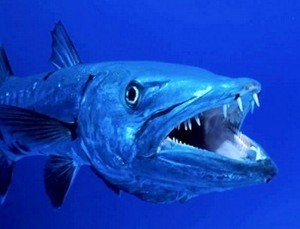
While large ‘Cudas have been known to carry the Ciguatera toxin (accumulated by eating certain reef fish) fish of 5 pounds and less have little or none of the toxin and won’t affect humans. Also, this is concentrated on specific reefs and rarely appears in the Florida Keys. They are an excellent tasting fish with white sweet meat.
More than their edibility they should be revered for their fishability. They are fast, aggressive feeders and are willing jumpers especially in shallower waters. The fact that they can be found in almost every marine environment from shallow backwaters to the reefs and deep sea only adds to their mystic.
Cudas can be found anywhere from 1 foot in length to occasionally 6 foot. Commonly available in 3 to 5 foot lengths. They are especially fun on light tackle, just remember the wire leader.
There are several fish in the Mackerel family that are similar looking and occasionally confused with the Barracuda. The one telling feature on the ‘Cuda are the large dark spots along the side of the belly.
Florida Record – Barracuda 67 lb Islamorada 01-29-49 H. K. Good
Barracuda Fishing by Lefty Kreh
Bonefish – Albula vulpes
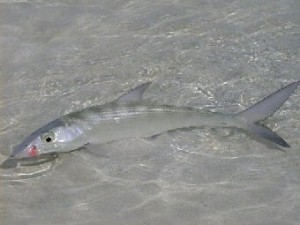
Sometimes referred to as the Grey Ghost, the Bonefish has become a major tourist attraction in the Florida Keys. Due to an almost exclusive “Catch and Release” policy the average size has continued to increase. Stalking the flats Flyfishing for Bonefish has become the norm. Average size is 6 to 8 lbs, with many 10 to 12 pounders caught each year. The current Florida Record is 15 lbs. 6 ozs.
If you haven’t done much bonefishing in the Keys it is highly recommended to hire a Guide to show you the ropes. Once you feel confident you can go it on your own.
The Bonefish is a silver gray slender fish with a downward facing mouth. They are primarily found in shallow inshore waters and are often found feeding on grass, mud or sand flats 1 to 3 feet deep.
The Bonefish feed in schools on shrimp, crabs and fish they root out on the bottom.
Florida Record – Bonefish 16 lb 3 oz Islamorada 03-99-07 R. Schroeder
Dolphin – Coryphaena Hippurus
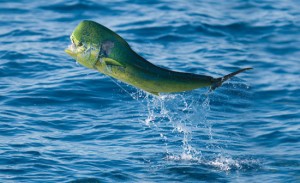
Also know as Mahi Mahi (Hawaiian) and Dorado (Caribbean) so as not to confuse this fish with the toothed whales, Porpoise or Bottlenosed Dolphin. This is one of the fastest growing fish (they can exceed 3 feet in their first year) which rarely live more than 5 years. They are also one of the fastest swimming fish achieving speeds estimated at 50 mph. Dolphin inhabit warm seas throughout the earth.
This is one fish that you can’t do justice to by photographing it out of the water. The colors of the live fish, especially while excited by baitfish, are not to be believed. With Bright greenish blue on the top third and yellow on the sides, they have the ability to flash purple, green and a wide range of other colors when excited. Irregular blue or golden blotches are scattered on their sides.
Their body tapers sharply from head to tail. The “forehead” on adult males is nearly vertical while the “forehead on young and females is more sloping. A tall single dark dorsal fin extends from just behind the head all the way to the tail.
Dolphin are commonly caught in the 30 to 50 pound range while schoolies are more commonly 3 to 7 pounds. The Florida record is 77 lbs. 12 ozs.
The life cycle of dolphin is quite remarkable. Dolphin are extremely fast-growing, but short-lived. Most dolphin only live a year or two, but the oldest fish can live up to around 4 years of age. Maximum size can be up to 5 or 6 feet (1.7 meters) and almost 90 lbs (40 kg). Dolphin fuel this fast growth rate, in excess of 3 feet in the first year, by eating mostly fish, particularly flying fish, mackerels, jacks, leatherjackets, and occasionally other dolphin. Dolphin are also capable of spawning during their first year of growth and may reproduce several times during a single spawning season.
Dolphin On A Fly by Dan Blanton
Florida Record – Dolphin 81 lb 0 oz Lantana 06-09-07 R. Vail
Sailfish – Istiophorus platypterus
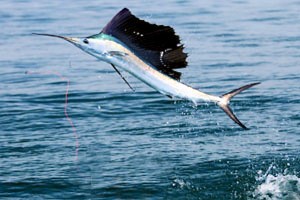
One of the more unusual groups of fish is the Billfish. They all have an elongated upper jaw in form of a spear. The Sailfish adds to this by having a huge tall dark blue dorsal fin looking somewhat like a sail, hence the name. They are blue above and silver below with a brownish area between.
Another very fast growing fish, reaching 4 to 5 feet the first year they are also fast swimmers approaching 50 mph. Due to Catch and Release they are commonly found to 7 feet again. The Florida record is 116 pounds.
Florida Record – Sailfish 126 lb Big Pine Key 06-13-09 L. Maier
Tarpon – Megalops atlanticus
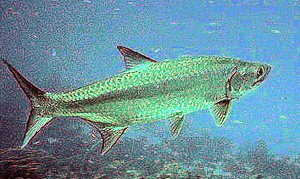
Often referred to as the Silver King, the Tarpon definitely lives up to its nickname. While the Tarpon in the Florida Keys may not be the largest you will find, they certainly are plentiful in the 40 to 50 pound range. Due to Catch and Release policies it is not unusual to find Tarpon in excess of 100 pounds. They are slow growers maturing at 7 to 13 years of age.
If you have used Pilchards as bait, just picture one on steroids and you have an idea of what a Tarpon looks like. They have huge scales and their mouths are quite boney and hard, making hooking somewhat difficult. This is one fish that will “throw the hook” more often than any other.
One of the first things a Tarpon will do when it feels a hook it leaps clear out of the water. They often follow baits all the way back to the boat before striking. This has provided an exciting experience for many anglers when a 4 to 6 foot Tarpon leaps 6 foot out of the water within 10 feet of the boat.
Once, in my youth, I was fishing on the seawall near the Seaquarium in Miami. I was not paying attention and dangling a live bait in the water just below me trying to decide where to cast it next. A Tarpon struck the bait and leaped so we were suddenly eye to eye about 4 feet apart. It threw the bait right at me and I almost fell into the water. This is still one of the most memorable occurrences in 40+ years of fishing.
Primarily an inshore fish, the adults spawn offshore and are a beautiful site when encountered while diving on a reef.
Florida Record – Tarpon 243 lb Key West 02-17-75 G. Bell
